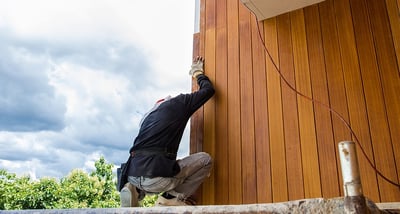Fiber cement is an interesting building material with a lot of applications. You’ll often find it used as siding, although there are uses for it indoors as well. When installing Fiber Cement, traditional nails or screws wont work with this material —but there are fastener alternatives out there. BECK offers the PANELFAST® Model 510A Nailer plus Fasteners to match. But we’ll get into that below! Keep reading to learn more about fiber cement and its uses.Fiber Cement: What is It?
This is a manufactured product, so exact ingredients will vary by manufacturer. In general, fiber cement boards and panels are made with cellulose fibers, Portland cement, sand, and water. Some will also contain additives to enhance durability, color, moisture resistance or other factors.
You’ll find fiber cement products in all kinds of shapes, sizes, and patterns. This includes both sheet and panel products as well as fiber cement boards. Some of it—particularly fiber cement designed as underlayment for showers or other such purposes—is relatively plain. Other fiber cement products are molded to resemble wood grain, the look of cedar shakes, scalloped edges, clapboard siding and so on.
Where to Use Fiber Cement?
There are lots of applications for fiber cement—as many as there are uses for plywood and dimensional lumber! When choosing what to use for a project, it’s best to learn a bit about the strengths and weaknesses of fiber cement first.
The upside of using fiber cement products is: It’s non-combustible and moisture resistant. It’s even pest resistant, whether those pests are termites or woodpeckers. While prices vary based on design and application, fiber cement generally falls somewhere in the middle of the price range.
What are the drawbacks to fiber cement? To start with, it can be brittle, which means it needs a lot of support to prevent cracking. Another issue is that it doesn’t offer much when it comes to insulation. If you are looking for a siding material capable of bumping up a wall assembly’s resale-value a notch or two, there are other products better suited for this.
With all of that said, fiber cement is best used where moisture, pests or fire hazards may present a problem. It is a great option to use behind shower walls and as floor underlayment in bathrooms to protect framing against potential leaks. Fiber cement also makes for an excellent siding material that will stand up to humid climates, resist the chewing of insects and animals, and help keep a home safe against potential fire hazards.
Using the Right Tools for Fiber Cement
When you’re working with fiber cement, what are the best tools to use? Choose a tool and fastener system that allows you to do quality work with efficiency. That means a nail gun—and the ET&F® PANELFAST® Model 510A is ideal in this instance. It’s designed to fire Panelfast® AGS-100 Pins, which are meant for use on gypsum, Fiberock, fiber cement siding, and vinyl siding. To learn more about this Nailer and Fastener System, click below.
.svg.png)

